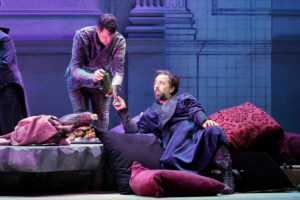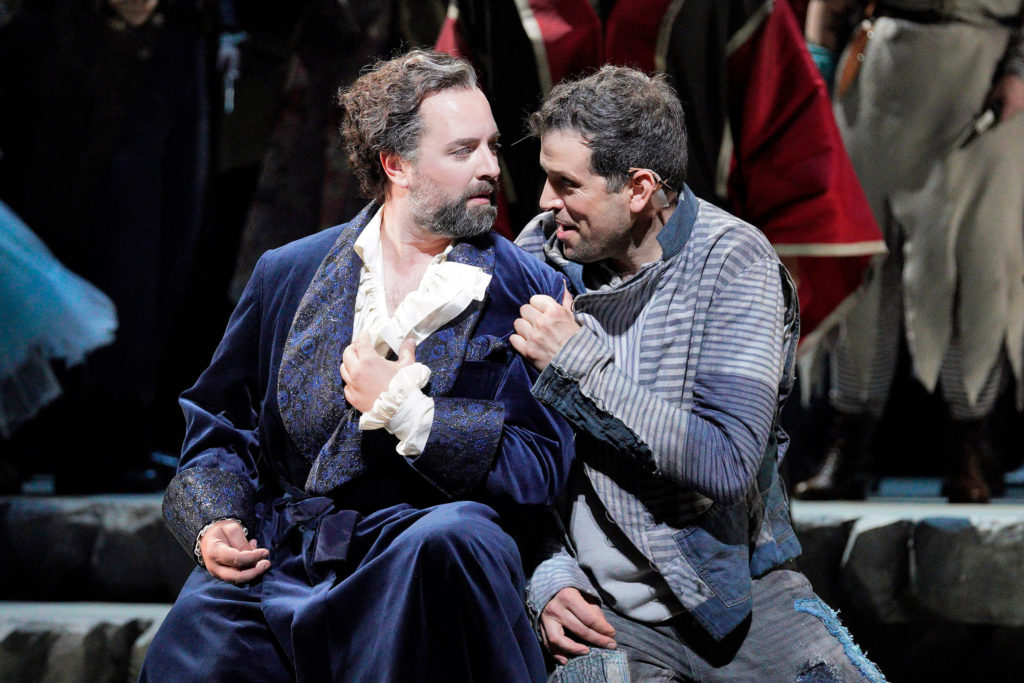
San Francisco Opera 2021-22 Review: Don Giovanni
Étienne Dupuis, Luca Pisaroni, Adela Zaharia, Nicole Car Shine in Mozart’s Masterpiece
By Lois SilversteinSan Francisco Opera’s summer production of Mozart’s dark comedy “Don Giovanni” gives us so much more than we could ever ask for from this operatic gem.
From the opening downbeat, conductor Bertrand de Billy led us through the variant plot twists and turns with the only questions being – Will we cheer for the great libertine’s demise? Or will we regret the loss of all that vitality? Will we brood with the women who were foiled by his foul play? Or will we say were you just too polite not to play?
This third part of the Mozart-DaPonte Trilogy at San Francisco Opera, created by director Michael Cavanagh, brought what it started in 2019 with “The Marriage of Figaro” set in colonial times, continued with “Cosi fan Tutte” in 2021 (set in the 1930s), to its conclusion, here with “Don Giovanni”in 2022, set in 2080.
300 Years of American Decay
The aim? To show America over a 300 year time span with the same American house as the set for the three productions. Its purpose is to show one narrative about the decline and fall of the world we live in through its dynamic period events. The creative team of set designer Erhard Rom, costume designer Constance Hoffman, and lighting designer Jane Cox, molded the three works into Cavanagh’s vision of one unified story. Although each production stands on its own, the resulting trilogy gives a thoughtful expression to the arc of history and the sameness of human appetites. Even so-called advancing technology hasn’t changed these fundamental impulses. Across the boards of the San Francisco War Memorial Opera House we saw rise and fall of this world’s life amidst torn American flags, lascivious human erotic appetites, and people following orders and impulses to keep the frame whole. A tall order.
As a result of the pandemic and house closure, the tasks of building the sets for “Don Giovanni” took six months rather than three, according to San Francisco Scene Shop Foreman John Del Bono. Quite possibly the most notable scenic element was the bust of the Commendatore that director Cavanagh envisioned for the Finale. It stood 24 feet tall and is composed of over 2000 pounds of Styrofoam. He said it took 232 man-days on that project alone. A special note concerns how they took special care to keep the result free from adhesives and contaminants so that the whole piece is recyclable.
From start to finish, “Don Giovanni” followed that script. The Overture, which Mozart apparently wrote one hour before the opening performance in 1787 was coupled with projections of smoke and flames across the set foreshadowing what was to come. Blurry figures, whirling smoke and rapidly moving clouds intersected in a suggestive chaotic wash. Weren’t these the twists and turns of the plot about to unfold ? No doubt – the seduction of Donna Anna and the murder of her father; the wild excoriations of Donna Elvira’s desertion; Zerlina’s temptations? Then there was the interchangeability of persons through appearance. Don Giovanni and Leporello in Act two, to sexual encounters of Don G with women across Europe, viz 1003 in Spain alone. The story was of indulgence, exploitation, and the satisfaction of doing what we want whether we say we want to or not. And then lying about it. And laughing about it. And going forward with sheer energy through the incredible show. A woman in a row or two behind me laughed herself happy in Act two at the folly of the women caught in his net. Was that man’s inhumanity to man? Or woman to woman? Or was this an expression of disappointment or delight with her gender?
Constance Hoffman used an eclectic mix in costumes to represent the dystopian future in 2080. In addition, she pulled a page off the streets of iconic and colorful San Francisco, complete with shopping cart crammed with the bits and pieces we find daily in abandoned or still usable wagons on our corners; hats and jackets tied around the waist, 18th century three-quarter coats, bathrobes, jeans, long and short dresses. While only seemingly incoherent, they matched the mood and atmosphere to the challenging evolving context and over time.
The lighting, was particularly stirring at the end of Act one, and certainly, during the climactic Finale, provided exciting contrast and dynamism.
The trilogy reflects what the Irish poet W. B. Yeats declared, “The center cannot hold./Mere anarchy is thrust upon the world/The blood-dimmed tide is loosed/And the ceremony of innocence is drowned.”
No matter how witty, this view threaded its way through the production, sets included.

Vocal Muscle & Flexibility All Around
The Don was sung with wit, fluency, and flirtatious panache by Canadian baritone Étienne Dupuis, who also looked the part – dashing, charming, full of courtly wiles of how to get a woman where he wanted her. In his romantic long coat, Dupuis gamboled around the stage with ease, singing his self-delight across Mozart’s remarkable melodies. The flexibility of the music rising and falling according to mood and clever guile were a perfect match. The music refreshed at each turn and and the Don’s delight for taking risks. Even as his own death hovered over him – being dragged down to hell into flames and smoke and roaring degradation – Dupuis’s Giovanni savored a “life well-lived,” in his very own style. Dupuis’ vocal prowess matched this physical ease. While the soloists and chorus gulped with chagrin at his fate – the death of their magnet and nemesis- they were gleeful that he was not going to be any more trouble in their lives. The Don rode herd on them all, like the anti-hero Mozart and Da Ponte meant him to be.
Leporello, sung by bass-baritone Luca Pisaroni, too was captivated by his master. Pisaroni’s choice vocally and theatrically perfectly fit the portrait he aimed to convey – clever and full of swagger but still a Don G acolyte.Their exchange reminded me of an extraordinary production done in 2006, in which Peter Sellars cast twin brother singers in muscle shirts and memorable dark voices as the pair. Easier to illustrate the idea afoot throughout the opera that one person is interchangeable with another , like it or not – perfect in the Sellars’ production with the twins. But Leporello does not leap to his master’s height or depth of degradation- he was only in awe of it, and this Don’s second-rate version of Leporello’s one-step up humaneness, further illustrated the class-system holding when we don’t actively work to overthrow it. Comic and witty by turns, the two pranced across the stage, however, in and out of doors, and the rising and falling stage panels, with aplomb, always enchanted by the trick they were weaving. It was at once something to savor but never to praise. They were adventurers after all, Casanovas in modern dress.
Masetto, sung by Cody Quattlebaum in his Company debut, and Don Ottavio, sung by former San Francisco Opera Adler Fellow Amitai Pati , did their duties as yearning and ailing lover, and subsequently behaving as a “good” man appropriate to his social class. The whole concept of interchangeability based on gender rather than the whole person was here too represented in their mostly stock characterizations. Wasn’t one like another? Weren’t we all puppets in the play of life?
Only the Commendatore, the singular voice of bass Soloman Howard, stepped out of the frame and was able to deliver the moral, which he did with consummate power.
As to the women, Donna Anna was sung by Romanian soprano Adela Zaharia, also in her Company debut. Throughout Act one, the content of her arias and her recitatives centered on lamentation for what she has suffered – first seduced and then left fatherless – only bit by bit learning that her self-pity was not the end of the tale. Her voice rose to lovely heights with ease and beauty with good contrasts throughout. By Act two, discovery that Don Giovanni was responsible for both of her losses, she rose to action and, in so doing, became a woman who aimed for more love and loyalty than she at first seemed. Her lovely aria, “Non mi fit, bell’idol mir/che son io crude con te,” illustrated this fully. Finally Donna Anna moved beyond her own self-indulgent absorption to genuine love for to her Don Ottavio. Here she poured her fluid legato into poignant expression, full of warmth and color.
Donna Elvira was sung by Australian soprano Nicole Car with a wide variety of vocal pyrotechnics and craft. From beginning to end, her Donna Elvira remained animated, active, physically vivacious. She sang with great flexibility and color, expressive in body as well as voice – she pivoted; she ran across the stage; she danced. This added a much desired dimension to the somewhat static less dance-like movement especially in the first Act, despite its movement of people from one side of the stage to another. Her voice retained its creamy luster even as she ranted and raved when she began to understand what a cad her “beloved” Don Giovanni was. While all ears to Leporello’s “Madamina” aria, she invoked her fury as well as her awe. Her vocal fireworks were more than satisfying: they elated. It was difficult not to keep all attention on her when she was on stage, regardless of what she was doing.
And Zerlina was sung with élan and great charm by soprano Christina Gansch, cavorting and prancing with ease throughout her scenes both with her peasant compatriots and with the Don and her Masetto. Her stage presence was exceptional. Her “Batti, batti” expressed the “naïve” country girl in love with her Masetto. But beyond this confession of sincerest faith, she also showed her attraction to Don Giovanni and her restraining herself mainly for reasons she’d hurt Masetto. Despite their “proper” behavior, Zerlina like Donna Anna, came across solely as victims when partly they were not. By the time she tied up Leporello in the “electric chair” – she was really into it, with no qualms, even to appreciating his disappearing act. She expected only the most outrageous antics from him. No wonder she attracted Don G. But while he, in man’s way, was able to pull off the dark and dirty, Zerlina remained the sprightly heroine without the bloodthirsty self-satisfaction of our main lothario. Her duet with Masetto best exemplified it.
Mozart’s glorious music shone under Bertrand de Billy’s baton, as only Mozart can, the instruments detailing characterizations with deft touch. The 51-piece orchestra, including continuo and mandolin stood out perfectly as a rose rises in the midst of a rich garden of gorgeous flowers. He brought out the Mozartian magic with sounds that stood above and beyond what was being dramatized on stage, despite at times a patient and too methodical periodicity prevailing above the fiery and voluptuous suggestiveness that powered the whole score. The arpeggios were there, the delicate tinsel of the winds, the volume surges, the precise order and dynamic thrust of the music – what a complete jewel, no matter how many times you hear it, no matter how much you just hear a phrase or an entire act – and we found ourselves wishing for more power and more intensity. Still, we couldn’t escape the enchantment of the textured and rhythmic melodies at each turn.
At the production’s end, however, we came away with a certain longing — perhaps a bit more of the erotic in the Don, and a bit more sensuosity in the seduction scenes, more anguished and believable grief and despair when things don’t go our way and a more passionate upsurge about how things could be when we check in on our own desires, and act accordingly.
San Francisco Opera ‘s “Don Giovanni” gives us pause.


